MIMO-OFDM Precoding with Phased Arrays
This example shows how phased arrays are used in a MIMO-OFDM communications system employing beamforming. Using components from Communications Toolbox™ and Phased Array System Toolbox™, it models the radiating elements that comprise a transmitter and the front-end receiver components, for a MIMO-OFDM communications system. With user-specified parameters, you can validate the performance of the system in terms of bit error rate and constellations for different spatial locations and array sizes.
The example uses functions and System objects™ from Communications Toolbox and Phased Array System Toolbox and requires
WINNER II Channel Model for Communications Toolbox
Introduction
MIMO-OFDM systems are the norm in current wireless systems (e.g. 5G NR, LTE, WLAN) due to their robustness to frequency-selective channels and high data rates enabled. With ever-increasing demands on data rates supported, these systems are getting more complex and larger in configurations with increasing number of antenna elements, and resources (subcarriers) allocated.
With antenna arrays and spatial multiplexing, efficient techniques to realize the transmissions are necessary [ 6 ]. Beamforming is one such technique, that is employed to improve the signal to noise ratio (SNR) which ultimately improves the system performance, as measured here in terms of bit error rate (BER) [ 1 ].
This example illustrates an asymmetric MIMO-OFDM single-user system where the maximum number of antenna elements on transmit and receive ends can be 1024 and 32 respectively, with up to 16 independent data streams. It models a spatial channel where the array locations and antenna patterns are incorporated into the overall system design. For simplicity, a single point-to-point link (one base station communicating with one mobile user) is modeled. The link uses channel sounding to provide the transmitter with the channel information it needs for beamforming.
The example offers the choice of a few spatially defined channel models, specifically a WINNER II Channel model and a scattering-based model, both of which account for the transmit/receive spatial locations and antenna patterns.
s = rng(61); % Set RNG state for repeatability
System Parameters
Define parameters for the system. These parameters can be modified to explore their impact on the system.
% Single-user system with multiple streams prm.numUsers = 1; % Number of users prm.numSTS = 16; % Number of independent data streams, 4/8/16/32/64 prm.numTx = 32; % Number of transmit antennas prm.numRx = 16; % Number of receive antennas prm.bitsPerSubCarrier = 6; % 2: QPSK, 4: 16QAM, 6: 64QAM, 8: 256QAM prm.numDataSymbols = 10; % Number of OFDM data symbols prm.fc = 4e9; % 4 GHz system prm.chanSRate = 100e6; % Channel sampling rate, 100 Msps prm.ChanType = 'Scattering'; % Channel options: 'WINNER', 'Scattering', % 'ScatteringFcn', 'StaticFlat' prm.NFig = 5; % Noise figure, dB % Array locations and angles prm.posTx = [0;0;0]; % BS/Transmit array position, [x;y;z], meters prm.mobileRange = 300; % meters % Angles specified as [azimuth;elevation], az=[-90 90], el=[-90 90] prm.mobileAngle = [33; 0]; % degrees prm.steeringAngle = [30; -20]; % Transmit steering angle (close to mobileAngle) prm.enSteering = true; % Enable/disable steering
Parameters to define the OFDM modulation employed for the system are specified below.
prm.FFTLength = 256; prm.CyclicPrefixLength = 64; prm.numCarriers = 234; prm.NumGuardBandCarriers = [7 6]; prm.PilotCarrierIndices = [26 54 90 118 140 168 204 232]; nonDataIdx = [(1:prm.NumGuardBandCarriers(1))'; prm.FFTLength/2+1; ... (prm.FFTLength-prm.NumGuardBandCarriers(2)+1:prm.FFTLength)'; ... prm.PilotCarrierIndices.';]; prm.CarriersLocations = setdiff((1:prm.FFTLength)',sort(nonDataIdx)); numTx = prm.numTx; numRx = prm.numRx; numSTS = prm.numSTS; prm.numFrmBits = numSTS*prm.numDataSymbols*prm.numCarriers* ... prm.bitsPerSubCarrier*1/3-6; % Account for termination bits prm.modMode = 2^prm.bitsPerSubCarrier; % Modulation order % Account for channel filter delay prm.numPadZeros = 3*(prm.FFTLength+prm.CyclicPrefixLength); % Get transmit and receive array information prm.numSTSVec = numSTS; [isTxURA,expFactorTx,isRxURA,expFactorRx] = helperArrayInfo(prm,true);
The processing for channel sounding, data transmission and reception modeled in the example are shown in the following block diagrams.

The free space path loss is calculated based on the base station and mobile station positions for the spatially-aware system modeled.
prm.cLight = physconst('LightSpeed'); prm.lambda = prm.cLight/prm.fc; % Mobile position [xRx,yRx,zRx] = sph2cart(deg2rad(prm.mobileAngle(1)),... deg2rad(prm.mobileAngle(2)),prm.mobileRange); prm.posRx = [xRx;yRx;zRx]; [toRxRange,toRxAng] = rangeangle(prm.posTx,prm.posRx); spLoss = fspl(toRxRange,prm.lambda); gainFactor = 1;
Channel Sounding
For a spatially multiplexed system, availability of channel information at the transmitter allows for precoding to be applied to maximize the signal energy in the direction and channel of interest. Under the assumption of a slowly varying channel, this is facilitated by sounding the channel first, wherein for a reference transmission, the receiver estimates the channel and feeds this information back to the transmitter.
For the chosen system, a preamble signal is sent over all transmitting antenna elements, and processed at the receiver accounting for the channel. The receiver components perform pre-amplification, OFDM demodulation, frequency domain channel estimation, and calculation of the feedback weights based on channel diagonalization using singular value decomposition (SVD) per data subcarrier.
% Generate the preamble signal preambleSigSTS = helperGenPreamble(prm); % repeat over numTx preambleSig = zeros(size(preambleSigSTS,1),numTx); for i = 1:numSTS preambleSig(:,(i-1)*expFactorTx+(1:expFactorTx)) = ... repmat(preambleSigSTS(:,i),1,expFactorTx); end % Transmit preamble over channel [rxPreSig,chanDelay] = helperApplyChannel(preambleSig,prm,spLoss); % Front-end amplifier gain and thermal noise rxPreAmp = phased.ReceiverPreamp( ... 'Gain',gainFactor*spLoss, ... % account for path loss 'NoiseFigure',prm.NFig, ... 'ReferenceTemperature',290, ... 'SampleRate',prm.chanSRate); rxPreSigAmp = rxPreAmp(rxPreSig); rxPreSigAmp = rxPreSigAmp * ... % scale power (sqrt(prm.FFTLength-sum(prm.NumGuardBandCarriers)-1)/(prm.FFTLength)); % OFDM Demodulation demodulatorOFDM = comm.OFDMDemodulator( ... 'FFTLength',prm.FFTLength, ... 'NumGuardBandCarriers',prm.NumGuardBandCarriers.', ... 'RemoveDCCarrier',true, ... 'PilotOutputPort',true, ... 'PilotCarrierIndices',prm.PilotCarrierIndices.', ... 'CyclicPrefixLength',prm.CyclicPrefixLength, ... 'NumSymbols',numSTS, ... % preamble symbols alone 'NumReceiveAntennas',numRx); rxOFDM = demodulatorOFDM( ... rxPreSigAmp(chanDelay+1:end-(prm.numPadZeros-chanDelay),:)); % Channel estimation from preamble % numCarr, numSTS, numRx hD = helperMIMOChannelEstimate(rxOFDM(:,1:numSTS,:),prm); % Calculate the feedback weights v = diagbfweights(hD);
For conciseness in presentation, front-end synchronization including carrier and timing recovery are assumed. The weights computed using diagbfweights are hence fed back to the transmitter, for subsequent application for the actual data transmission.
Data Transmission
Next, we configure the system's data transmitter. This processing includes channel coding, bit mapping to complex symbols, splitting of the individual data stream to multiple transmit streams, precoding of the transmit streams, OFDM modulation with pilot mapping and replication for the transmit antennas employed.
% Convolutional encoder encoder = comm.ConvolutionalEncoder( ... 'TrellisStructure',poly2trellis(7,[133 171 165]), ... 'TerminationMethod','Terminated'); % Generate mapped symbols from bits txBits = randi([0, 1],prm.numFrmBits,1); encodedBits = encoder(txBits); % Bits to QAM symbol mapping mappedSym = qammod(encodedBits,prm.modMode,'InputType','Bit', ... 'UnitAveragePower',true); % Map to layers: per symbol, per data stream gridData = reshape(mappedSym,prm.numCarriers,prm.numDataSymbols,numSTS); % Apply normalized precoding weights to the subcarriers, assuming perfect feedback P = complex(zeros(numSTS,numSTS,prm.numCarriers)); for carrIdx = 1:prm.numCarriers Q = squeeze(v(carrIdx,:,:)); normQ = Q * sqrt(numTx)/norm(Q,'fro'); % normalize P(:,:,carrIdx) = normQ; end preData = ofdmPrecode(gridData,P); % OFDM modulation of the data modulatorOFDM = comm.OFDMModulator( ... 'FFTLength',prm.FFTLength,... 'NumGuardBandCarriers',prm.NumGuardBandCarriers.',... 'InsertDCNull',true, ... 'PilotInputPort',true,... 'PilotCarrierIndices',prm.PilotCarrierIndices.',... 'CyclicPrefixLength',prm.CyclicPrefixLength,... 'NumSymbols',prm.numDataSymbols,... 'NumTransmitAntennas',numSTS); % Multi-antenna pilots pilots = helperGenPilots(prm.numDataSymbols,numSTS); txOFDM = modulatorOFDM(preData,pilots); txOFDM = txOFDM * (prm.FFTLength/ ... sqrt(prm.FFTLength-sum(prm.NumGuardBandCarriers)-1)); % scale power % Generate preamble with the feedback weights and prepend to data preambleSigD = helperGenPreamble(prm,v); txSigSTS = [preambleSigD;txOFDM]; % Repeat over numTx txSig = zeros(size(txSigSTS,1),numTx); for i = 1:numSTS txSig(:,(i-1)*expFactorTx+(1:expFactorTx)) = ... repmat(txSigSTS(:,i),1,expFactorTx); end
For precoding, the preamble signal is regenerated to enable channel estimation. It is prepended to the data portion to form the transmission packet which is then replicated over the transmit antennas.
Transmit Beam Steering
Phased Array System Toolbox offers components appropriate for the design and simulation of phased arrays used in wireless communications systems.
For the spatially aware system, the signal transmitted from the base station is steered towards the direction of the mobile, so as to focus the radiated energy in the desired direction. This is achieved by applying a phase shift to each antenna element to steer the transmission.
The example uses a linear or rectangular array at the transmitter, depending on the number of data streams and number of transmit antennas selected.
% Gain per antenna element amplifier = phased.Transmitter('PeakPower',1/numTx,'Gain',0); % Amplify to achieve peak transmit power for each element for n = 1:numTx txSig(:,n) = amplifier(txSig(:,n)); end % Transmit antenna array definition if isTxURA % Uniform Rectangular array arrayTx = phased.URA([expFactorTx,numSTS],[0.5 0.5]*prm.lambda, ... 'Element',phased.IsotropicAntennaElement('BackBaffled',true)); else % Uniform Linear array arrayTx = phased.ULA(numTx, ... 'ElementSpacing',0.5*prm.lambda, ... 'Element',phased.IsotropicAntennaElement('BackBaffled',true)); end % For evaluating weights for steering SteerVecTx = phased.SteeringVector('SensorArray',arrayTx, ... 'PropagationSpeed',prm.cLight); % Generate weights for steered direction wT = SteerVecTx(prm.fc,prm.steeringAngle); % Radiate along the steered direction, without signal combining radiatorTx = phased.Radiator('Sensor',arrayTx, ... 'WeightsInputPort',true, ... 'PropagationSpeed',prm.cLight, ... 'OperatingFrequency',prm.fc, ... 'CombineRadiatedSignals',false); if prm.enSteering txSteerSig = radiatorTx(txSig,repmat(prm.mobileAngle,1,numTx), ... conj(wT)); else txSteerSig = txSig; end % Visualize the array h = figure('Position',figposition([10 55 22 35]),'MenuBar','none'); h.Name = 'Transmit Array Geometry'; viewArray(arrayTx); % Visualize the transmit pattern and steering h = figure('Position',figposition([32 55 22 30]),'MenuBar','none'); h.Name = 'Transmit Array Response Pattern'; pattern(arrayTx,prm.fc,'PropagationSpeed',prm.cLight,'Weights',wT); h = figure('Position',figposition([54 55 22 35]),'MenuBar','none'); h.Name = 'Transmit Array Azimuth Pattern'; patternAzimuth(arrayTx,prm.fc,'PropagationSpeed',prm.cLight,'Weights',wT); if isTxURA h = figure('Position',figposition([76 55 22 35]),'MenuBar','none'); h.Name = 'Transmit Array Elevation Pattern'; patternElevation(arrayTx,prm.fc,'PropagationSpeed',prm.cLight, ... 'Weights',wT); end
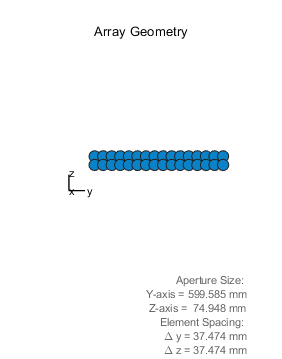
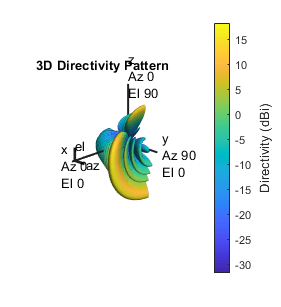
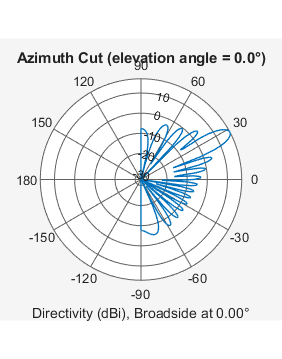
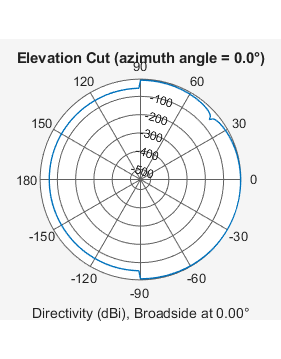
The plots indicate the array geometry and the transmit array response in multiple views. The response shows the transmission direction as specified by the steering angle.
The example assumes the steering angle known and close to the mobile angle. In actual systems, this would be estimated from angle-of-arrival estimation at the receiver as a part of the channel sounding or initial beam tracking procedures.
Signal Propagation
The example offers three options for spatial MIMO channels and a simpler static-flat MIMO channel for evaluation purposes.
The WINNER II channel model [ 5 ] is a spatially defined MIMO channel that allows you to specify the array geometry and location information. It is configured to use the typical urban microcell indoor scenario with very low mobile speeds.
The two scattering based channels use a single-bounce path through each scatterer where the number of scatterers is user-specified. For this example, the number of scatterers is set to 100. The 'Scattering' option models the scatterers placed randomly within a circle in between the transmitter and receiver, while the 'ScatteringFcn' models their placement completely randomly.
The models allow path loss modeling and both line-of-sight (LOS) and non-LOS propagation conditions. The example assumes non-LOS propagation and isotropic antenna element patterns with linear geometry.
% Apply a spatially defined channel to the steered signal
[rxSig,chanDelay] = helperApplyChannel(txSteerSig,prm,spLoss,preambleSig);
The same channel is used for both sounding and data transmission, with the data transmission having a longer duration controlled by the number of data symbols parameter, prm.numDataSymbols.
Receive Beam Steering
The receiver steers the incident signals to align with the transmit end steering, per receive element. Thermal noise and receiver gain are applied. Uniform linear or rectangular arrays with isotropic responses are modeled to match the channel and transmitter arrays.
rxPreAmp = phased.ReceiverPreamp( ... 'Gain',gainFactor*spLoss, ... % accounts for path loss 'NoiseFigure',prm.NFig, ... 'ReferenceTemperature',290, ... 'SampleRate',prm.chanSRate); % Front-end amplifier gain and thermal noise rxSigAmp = rxPreAmp(rxSig); rxSigAmp = rxSigAmp * ... % scale power (sqrt(prm.FFTLength - sum(prm.NumGuardBandCarriers)-1)/(prm.FFTLength)); % Receive array if isRxURA % Uniform Rectangular array arrayRx = phased.URA([expFactorRx,numSTS],0.5*prm.lambda, ... 'Element',phased.IsotropicAntennaElement('BackBaffled',true)); else % Uniform Linear array arrayRx = phased.ULA(numRx, ... 'ElementSpacing',0.5*prm.lambda, ... 'Element',phased.IsotropicAntennaElement); end % For evaluating receive-side steering weights SteerVecRx = phased.SteeringVector('SensorArray',arrayRx, ... 'PropagationSpeed',prm.cLight); % Generate weights for steered direction towards mobile wR = SteerVecRx(prm.fc,toRxAng); % Steer along the mobile receive direction if prm.enSteering rxSteerSig = rxSigAmp.*(wR'); else rxSteerSig = rxSigAmp; end % Visualize the array h = figure('Position',figposition([10 20 22 35]),'MenuBar','none'); h.Name = 'Receive Array Geometry'; viewArray(arrayRx); % Visualize the receive pattern and steering h = figure('Position',figposition([32 20 22 30])); h.Name = 'Receive Array Response Pattern'; pattern(arrayRx,prm.fc,'PropagationSpeed',prm.cLight,'Weights',wR); h = figure('Position',figposition([54 20 22 35]),'MenuBar','none'); h.Name = 'Receive Array Azimuth Pattern'; patternAzimuth(arrayRx,prm.fc,'PropagationSpeed',prm.cLight,'Weights',wR); if isRxURA figure('Position',figposition([76 20 22 35]),'MenuBar','none'); h.Name = 'Receive Array Elevation Pattern'; patternElevation(arrayRx,prm.fc,'PropagationSpeed',prm.cLight, ... 'Weights',wR); end
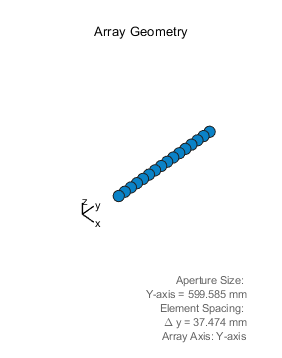
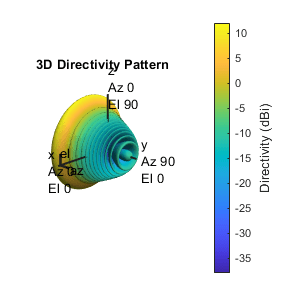
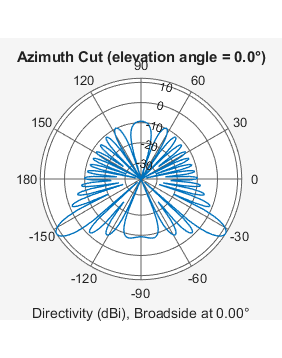
The receive antenna pattern mirrors the transmission steering.
Signal Recovery
The receive antenna array passes the propagated signal to the receiver to recover the original information embedded in the signal. Similar to the transmitter, the receiver used in a MIMO-OFDM system contains many components, including OFDM demodulator, MIMO equalizer, QAM demodulator, and channel decoder.
demodulatorOFDM = comm.OFDMDemodulator( ... 'FFTLength',prm.FFTLength, ... 'NumGuardBandCarriers',prm.NumGuardBandCarriers.', ... 'RemoveDCCarrier',true, ... 'PilotOutputPort',true, ... 'PilotCarrierIndices',prm.PilotCarrierIndices.', ... 'CyclicPrefixLength',prm.CyclicPrefixLength, ... 'NumSymbols',numSTS+prm.numDataSymbols, ... % preamble & data 'NumReceiveAntennas',numRx); % OFDM Demodulation rxOFDM = demodulatorOFDM( ... rxSteerSig(chanDelay+1:end-(prm.numPadZeros-chanDelay),:)); % Channel estimation from the mapped preamble hD = helperMIMOChannelEstimate(rxOFDM(:,1:numSTS,:),prm); % MIMO Equalization [rxEq,CSI] = ofdmEqualize(rxOFDM(:,numSTS+1:end,:),hD); % Soft demodulation scFact = ((prm.FFTLength-sum(prm.NumGuardBandCarriers)-1) ... /prm.FFTLength^2)/numTx; nVar = noisepow(prm.chanSRate,prm.NFig,290)/scFact; rxSymbs = rxEq(:)/sqrt(numTx); rxLLRBits = qamdemod(rxSymbs,prm.modMode,'UnitAveragePower',true, ... 'OutputType','approxllr','NoiseVariance',nVar); % Apply CSI prior to decoding rxLLRtmp = reshape(rxLLRBits,prm.bitsPerSubCarrier,[], ... prm.numDataSymbols,numSTS); csitmp = reshape(CSI,1,[],1,numSTS); rxScaledLLR = rxLLRtmp.*csitmp; % Soft-input channel decoding decoder = comm.ViterbiDecoder(... 'InputFormat','Unquantized', ... 'TrellisStructure',poly2trellis(7, [133 171 165]), ... 'TerminationMethod','Terminated', ... 'OutputDataType','double'); rxDecoded = decoder(rxScaledLLR(:)); % Decoded received bits rxBits = rxDecoded(1:prm.numFrmBits);
For the MIMO system modeled, the displayed receive constellation of the equalized symbols offers a qualitative assessment of the reception. The actual bit error rate offers the quantitative figure by comparing the actual transmitted bits with the received decoded bits.
% Display received constellation constDiag = comm.ConstellationDiagram( ... 'SamplesPerSymbol',1, ... 'ShowReferenceConstellation',true, ... 'ReferenceConstellation', ... qammod((0:prm.modMode-1)',prm.modMode,'UnitAveragePower',true), ... 'ColorFading',false, ... 'Position',figposition([20 20 35 40]), ... 'Title','Equalized Symbols', ... 'EnableMeasurements',true, ... 'MeasurementInterval',length(rxSymbs)); constDiag(rxSymbs); % Compute and display bit error rate ber = comm.ErrorRate; measures = ber(txBits,rxBits); fprintf('BER = %.5f; No. of Bits = %d; No. of errors = %d\n', ... measures(1),measures(3),measures(2)); rng(s); % Restore RNG state
BER = 0.00000; No. of Bits = 74874; No. of errors = 0
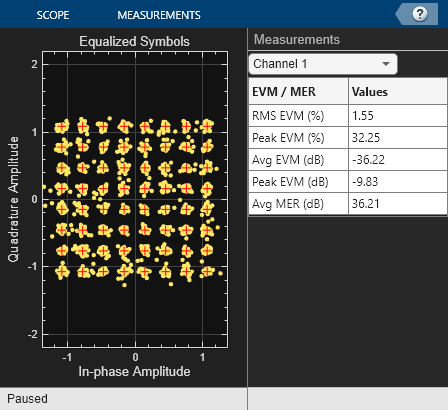
Conclusion and Further Exploration
The example highlighted the use of phased antenna arrays for a beamformed MIMO-OFDM system. It accounted for the spatial geometry and location of the arrays at the base station and mobile station for a single user system. Using channel sounding, it illustrated how precoding is realized in current wireless systems and how steering of antenna arrays is modeled.
Within the set of configurable parameters, you can vary the number of data streams, transmit/receive antenna elements, station or array locations and geometry, channel models and their configurations to study the parameters' individual or combined effects on the system. E.g. vary just the number of transmit antennas to see the effect on the main lobe of the steered beam and the resulting system performance.
The example also made simplifying assumptions for front-end synchronization, channel feedback, user velocity and path loss models, which need to be further considered for a practical system. Individual systems also have their own procedures which must be folded in to the modeling [ 2, 3, 4 ].
Explore the following helper functions used:
helperApplyChannel.mhelperArrayInfo.mhelperGenPilots.mhelperGenPreamble.mhelperGetP.mhelperMIMOChannelEstimate.m
Selected Bibliography
Perahia, Eldad, and Robert Stacey. Next Generation Wireless LANS: 802.11n and 802.11ac. Cambridge University Press, 2013.
IEEE® Std 802.11™-2012 IEEE Standard for Information technology - Telecommunications and information exchange between systems - Local and metropolitan area networks - Specific requirements - Part 11: Wireless LAN Medium Access Control (MAC) and Physical Layer (PHY) Specifications.
3GPP TS 36.213. "Physical layer procedures." 3rd Generation Partnership Project; Technical Specification Group Radio Access Network; Evolved Universal Terrestrial Radio Access (E-UTRA). URL: https://www.3gpp.org.
3GPP TS 36.101. "User Equipment (UE) Radio Transmission and Reception." 3rd Generation Partnership Project; Technical Specification Group Radio Access Network; Evolved Universal Terrestrial Radio Access (E-UTRA). URL: https://www.3gpp.org.
Kyosti, Pekka, Juha Meinila, et al. WINNER II Channel Models. D1.1.2, V1.2. IST-4-027756 WINNER II, September 2007.
George Tsoulos, Ed., "MIMO System Technology for Wireless Communications", CRC Press, Boca Raton, FL, 2006.